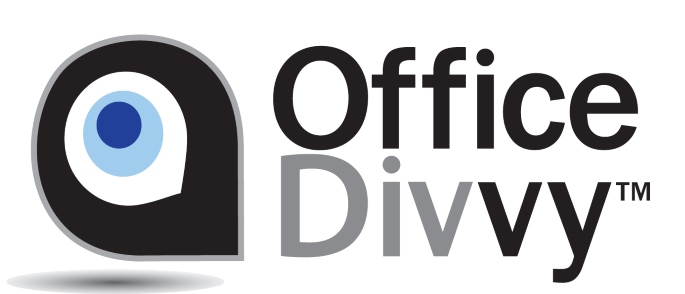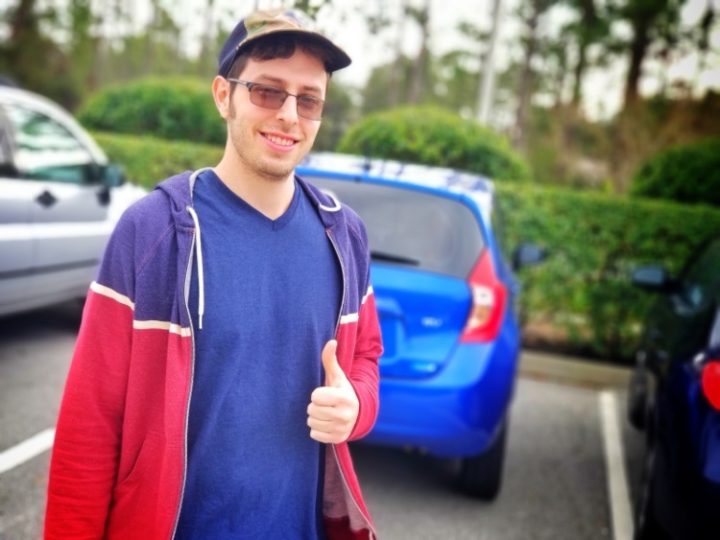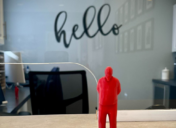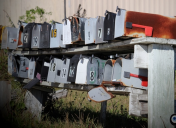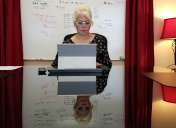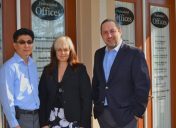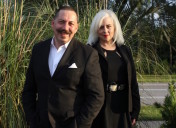COWORKING From Palm Coast to LAX
Among travel-heads and expeditionists, it goes without saying…
The best way to experience a new place, particularly when just passing through, is to grab a local nosh somewhere. Assuming, of course, it’s truly local and an authentic piece of the neighborhood. But if you’re a footloose freelancer or entrepreneur, perhaps there’s another way. One you probably haven’t considered.
Rather than thinking in terms of food, ever consider getting some work done instead?
Yes, that sounds counter-intuitive, but recently, I did some traveling—embarking upon what’s been popularly coined the “American Tradition,” in which I drove some 2,500 miles west via I-10 from Palm Coast to Los Angeles. I won’t bore you with all the typical revelations you’d expect me to experience on such a voyage, except for when it comes to one matter in particular.
This is the realization that as a freelancer it’s never been easier to take such a furlough, despite any harboring productivity concerns. The reason is the surging Coworking culture sweeping the world since roughly the early 2010s.
A forecast report put out last year estimated that by 2020 there’ll be more than 26,000 Coworking spaces globally, with 3.8 million members.
Actually, the fact that a Coworking site emerged in “little” Palm Coast at all and earlier still (2008) at Office Divvy says enough on that front alone.
But the real takeaway is that Coworking can actually become part of your trip.
While virtually all Coworking spots manifest certain communal chameleonic traits– and relatively similar packages–they can also become a special part of the city to which they play resident. They can also stand apart.
The point being, no longer do workers on a budget need to lock themselves in a lonely Motel 6 room with spotty Wifi or battle for a free seat at an overcrowded Starbucks to get some work done. There are other ways, should they decide to brave a similar adventure.
So, below in this somewhat atypical travel log, you’ll notice none of my layovers fall into the big box, corporate category, though I did attempt a conclusion at one of the myriad Los Angeles We Work locations for contrast. Unfortunately, their New York press office declined to be part of this adventure, ignoring multiple requests for a tour/interview.
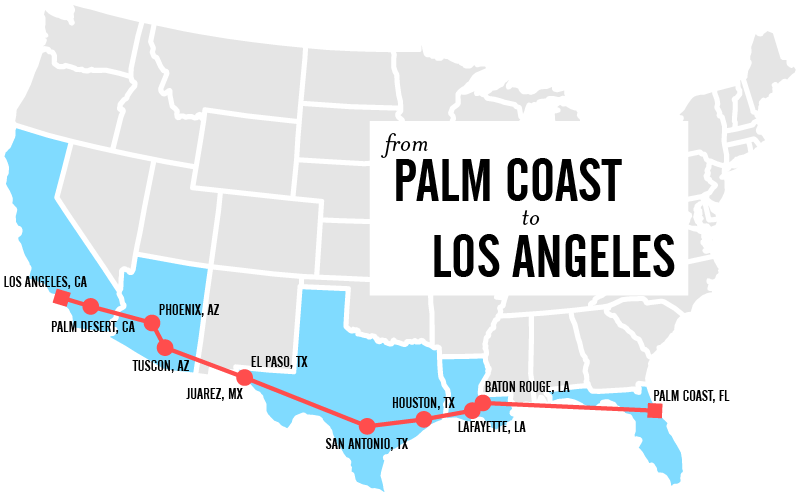
And so the adventure began, my first stopover scheduled a mere 10 hours into the approximately 36 hour drive. The first 1,820 miles of the total 2,500, a mere bag of shells.
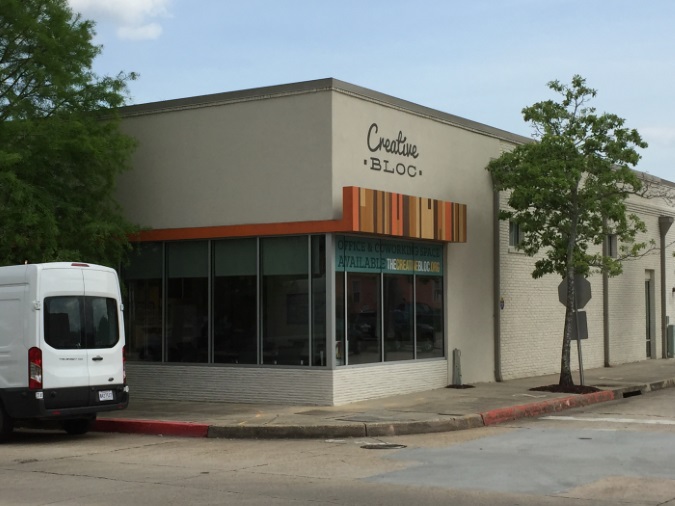
An outside look at the Creative Bloc.
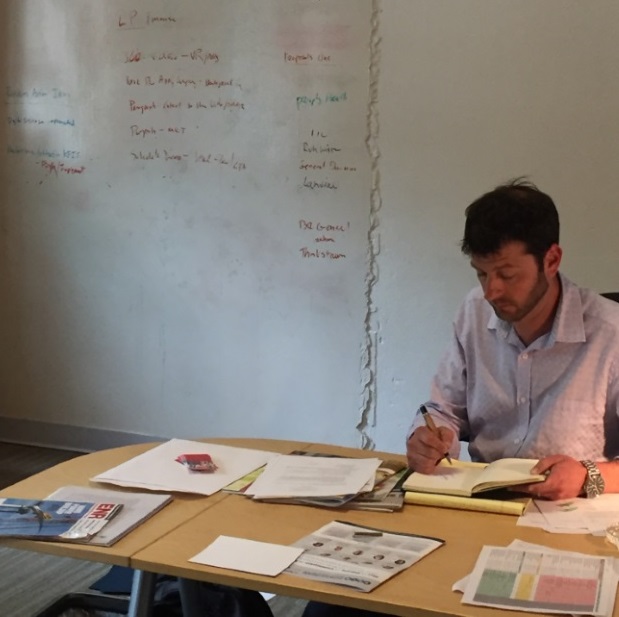
John Jackson at his desk in front of a giant scalloped whiteboard.
According to founder John Jackson, the Creative Bloc was the first Coworking location to sprout up in Baton Rouge, Louisiana, a city known for its big energy sector. Something that’s much lesser known to outsiders is that Baton Rouge managed for a long time to maintain a spot as a bustling player within the world of film and television, a fact that speaks to a portion, at least, of this stop’s desired clientele. (The day I was there, in fact, the streets were taped off for a filming.)
Jackson has taken great pains to make the Creative Bloc something more than just another stodgy, beige office building in a city full of them. He reused as much of the building materials and mortar from the original 1930s storefront as possible. A dramatic gas explosion around the same time the building was erected gave him more to work with in this regard, including, possibly, the massive whiteboard scalloped directly into the back wall of his office.
The idea was to retail a new kind of work life for mostly creatives types. Jackson, however, is positioned by his location to reach many more types than just those.
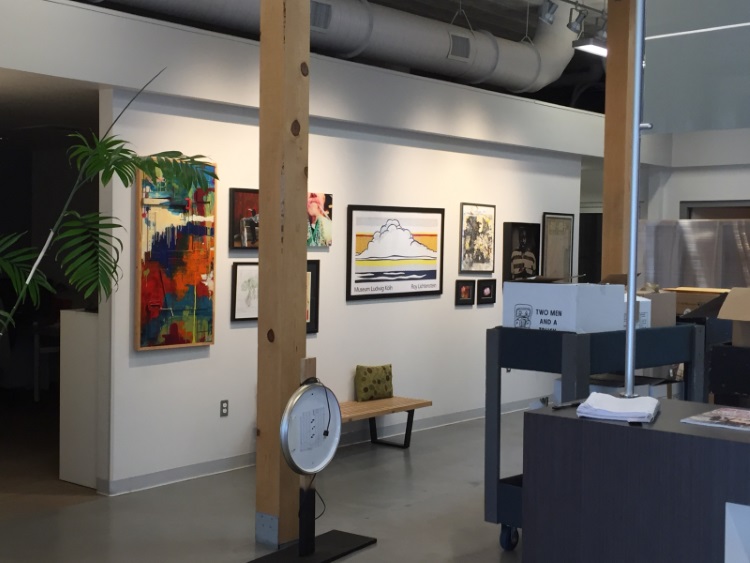
The tastefully decorated interior walk-around and communal work space.
Baton Rouge is Louisiana’s legislative seat, so the Creative Bloc, is situated to lure in bureaucrats as well as artists, particularly during the legislative session.
Jackson originally took over the L-Shaped 11,300-square-foot complex to house his video production company, but found he had some extra room. An NPR story about a German coffee shop that monetized time rather than coffee planted the Coworking concept into his head…
“It was a means to an end,” he said, but certainly “not the plan.”
Their tag line: “Old Walls meet new ideas.”
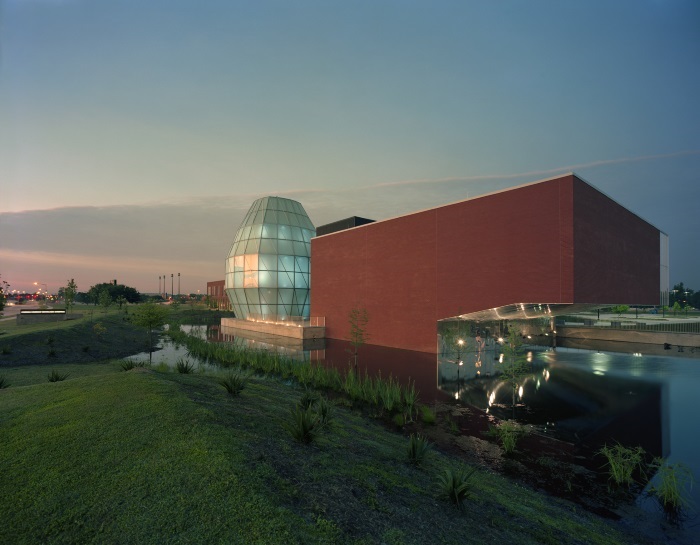
Sharp angle of Lafayette’s prized Startup incubator, the Opportunity Machine. (Courtesy of the Lite Building)
My second Coworking stop, the Opportunity Machine in Lafayette, Louisiana, occupied more strikingly modern-looking digs than just about anywhere else I visited. That was within the $27 million state-of-the-art, 70,000-square-foot Louisiana Immersive Technologies Enterprise or LITE building, a giant glass egg perched on the edifice above green bayou esque waters, creating a Louisiana Oz-like exterior.
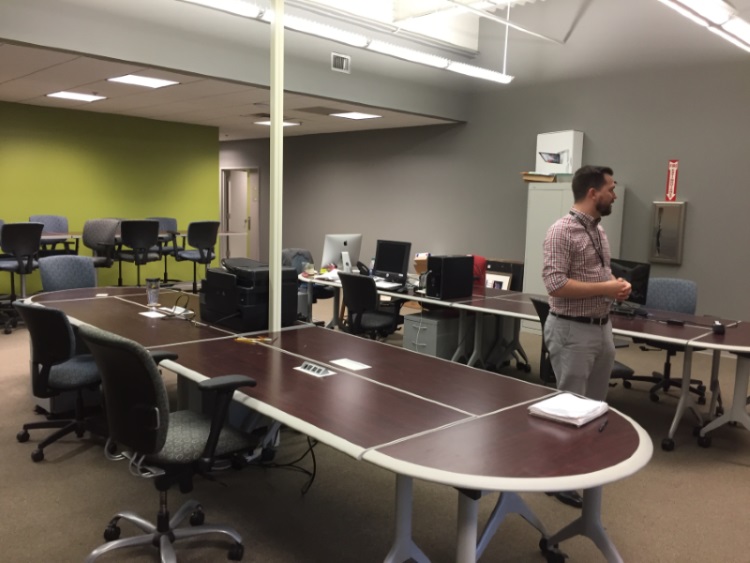
Destin Ortego shows off the OM communal Coworking space within the LITE Building.
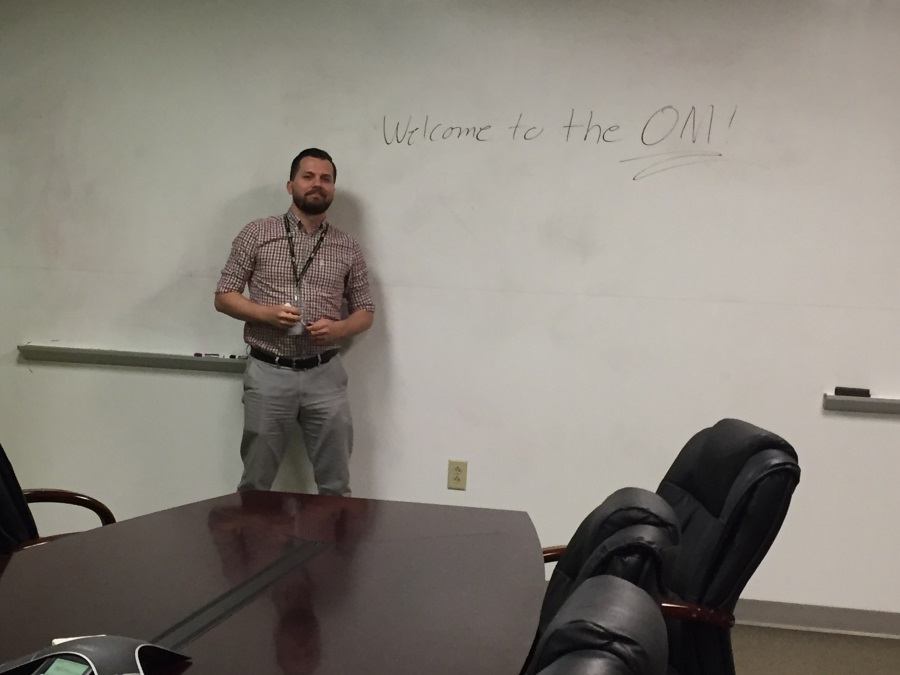
Destin Ortego role-playing before the whiteboard used for entrepreneur workshops.
However, the program coordinator Destin Ortego for the OM, as they like to call it, presented a pretty modest explanation in describing what takes place inside its walls.
“Think of it as a CC’s Coffee House…Except a little more professional…So the concept is basically to bring people in–if you have an idea, kind of just scribble it on a napkin. Then you can kind of start in the Coworking space,” he said. “It’s like college for entrepreneurs, but the goal is to graduate out.”
Technically, the OM is designed as a tech incubator, but that designation can give the wrong idea, Ortega said.
“But really, what is a tech company,” Ortega asked me.
The answer is somewhat a wash. “Really almost anything can be considered a tech company nowadays,” he said, referencing a client, an Arcadian sports league, that conducts most business through its website.
The OM started as a “quasi-government entity,” but at the beginning of this year made the transition into a membership-based non-profit, he said.
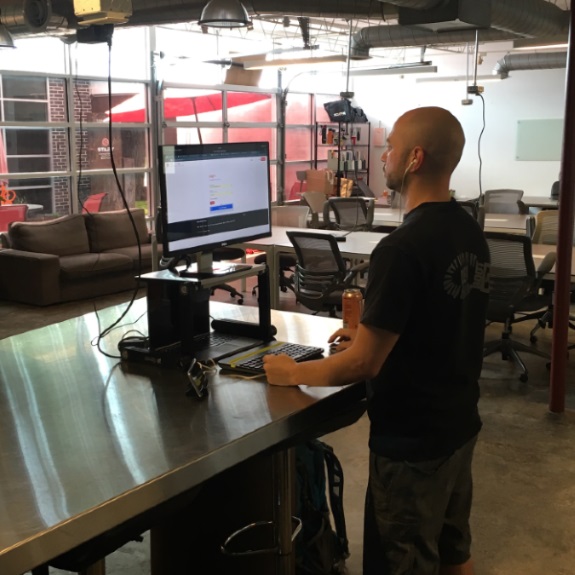
Start Houston prides itself on having a more casual, “Come as you are” mentality. (Courtesy of Start Houston)
Closing in on the halfway juncture, entering Texas, I next landed in “Space City”—Houston. I found the Coworking hub Start on a leafy quiet side street just outside the noiser reaches of East Downtown.
According to Community Manager John Frasier, who is also an equity partner of the startup, Start was a direct response to the 2007 financial crisis when one of the originators, Apurva Sanghavi, was working in New York as one of the original employees for the online residential real estate behemoth Trulia.
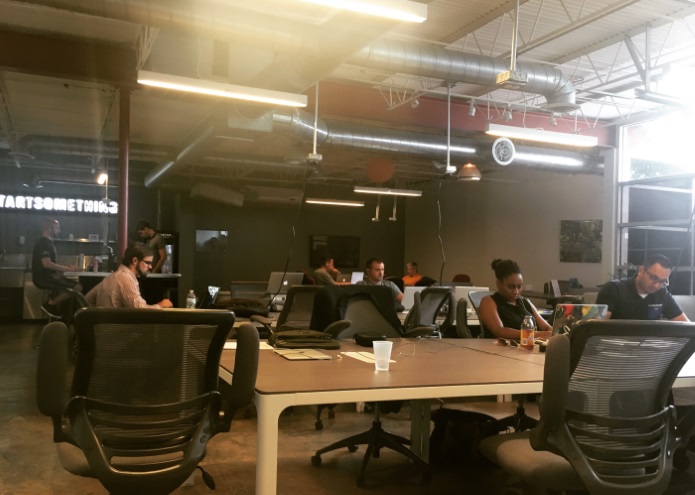
Coworking in the main room of Start Houston. (Courtesy of Start Houston)
He saw a lot of bankers losing their jobs and forming entrepreneurial Coworking enclaves, he said—trying to make the best of a bad situation. Sanghavi was inspired to bring the concept back to Houston–the primary industries of which are tech and energy. Jackson admitted the city can be, generally, fickle when it comes to new emerging businesses.
“Houston is actually a place where, whatever you create, it becomes its own thing,” he said.
“If you try to force something onto Houston, it just doesn’t work… With that being said, we’re always last to adapt to whatever’s trendy…”
The slogan accompanying Start’s brand of Texan-style individualism: “Just Start Something.”
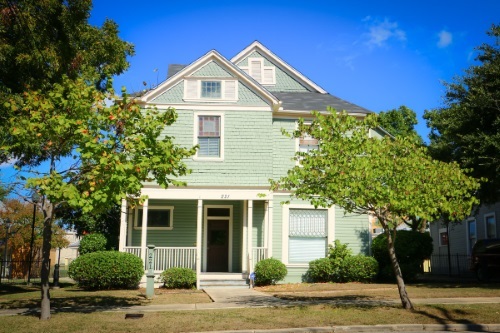
The exterior facade to one of the homes that constitute San Antonio’s The Workery. (Courtesy of The Workery)
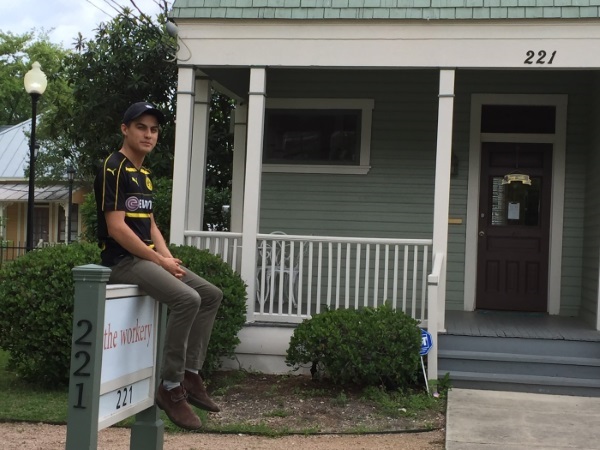
Workery Community Manager and Borussia Dortmund soccer fan, Mike Serna poses like a neighborhood kid in the front yard.
San Antonio hosts the most homey hive I encountered during my travels. The Workery is the brain child of former Rack Space employees trying to get back to the grass roots, according to the very hospitable community manager Miguel Serna.
With that said, the tall Victorian home located at the placid residential address of 221 Poplar, which looks out upon the historic 1930s era gothic Aurora Apartment Hotel high-rise, puts most of its effort into helping organizations and Startups which are, by mission, strongly community-oriented.
“Make this a home for your business.”
This is the running theme, said Serna–a recent college graduate hailing from the small Texas border town of Laeredo.
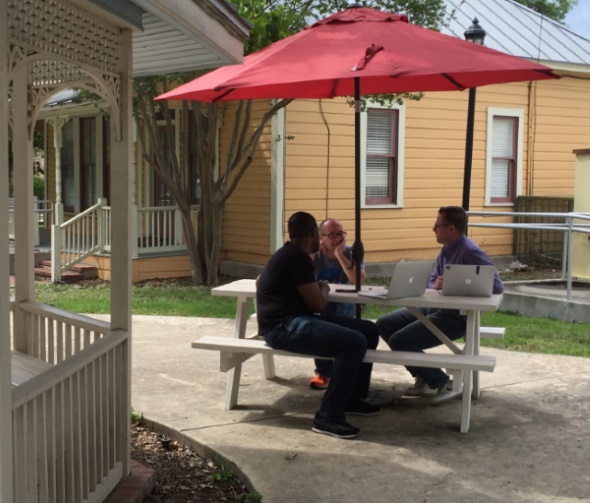
Entrepreneurs brainstorm in The Workery’s courtyard on a muggy afternoon–a huge Texas thunderstorm on the way.
His experience and exposure to business here at The Workery has been eye-opening and speaks to the value of moving in search of something new, even if it’s only a couple of hours away. “They don’t have anything like this,” he said reverently, referring to his hometown.
San Antonio’s culture is heavily Mexican influenced, and there are accents of it permeating out of The Workery, particularly in the way they go about business, he said.
“I’m not sure if you’re familiar with Mexican culture…It’s very family-oriented, real receiving—a bring them in, receive them, feed them, take care of them type of situation.”
As I was there on Good Friday, the city’s Mexican flavor was even more on the palate than usual.
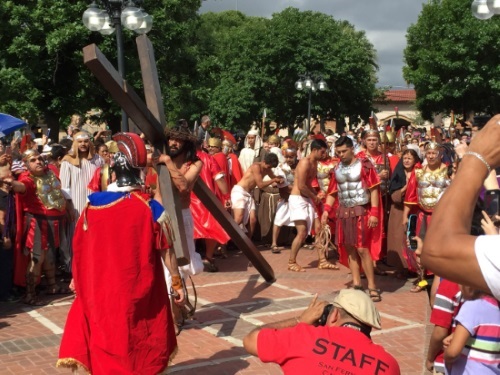
Sights and scenes from the streets and squares in San Antonio on Good Friday.
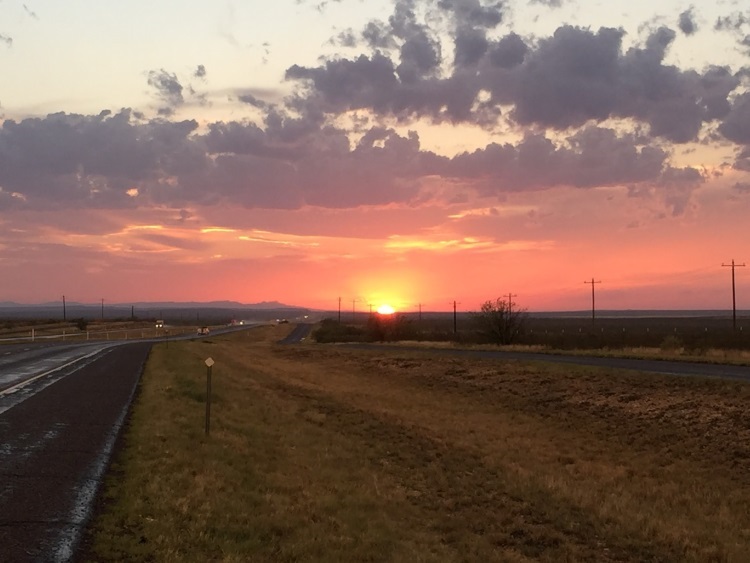
Commencing the halfway point of my trip, a sunset during the longest leg of the drive–a straight shot from San Antonio to El Paso, Texas.
With Texas successfully traversed, I was relieved to have passed the halfway threshold and to enter Arizona.
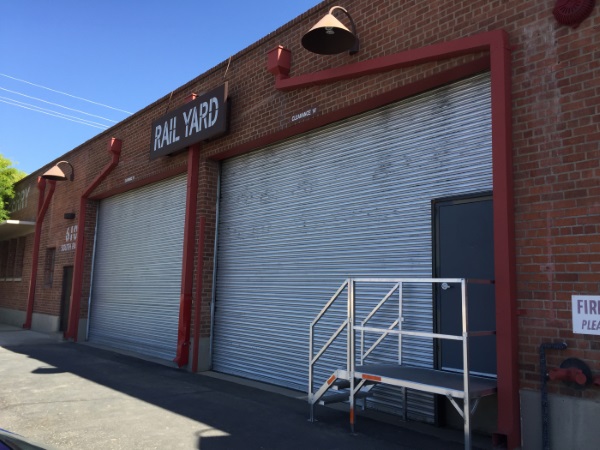
The scrappy garage-like veneer of The Rail Yard in Tuscon, Arizona.
In Tuscon, an ostensibly blue collar, bluesy city, my next Coworking destination played up that theme. The Rail Yard, as it’s named, sits across the street from the Southern Pacific Transportation Company and maintenance yard. There, more than 120 trains enter and leave Tuscon each day. In the 1950s, there was an old roundhouse or train storage yard, according to Phil Perry who transported his former Roman shade and furniture production company to the old paper warehouse.
“That’s why there’re sprinklers everywhere,” he said.
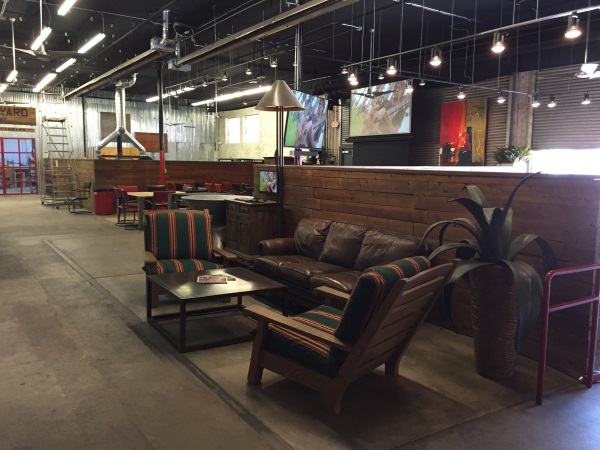
Long view of the Rail Yard’s interior urbane communal area.
But listening to Perry, one shouldn’t get the wrong idea from the earthy facade or the building’s background.

What remains of Perry’s manufacturing business Perry Design, now called Perry Luxe and run by his son, a Rail Yard client.
“Our demographic is creative and generally more mature…People your age (late stage millennial) generally don’t have the money to afford this,” he said.
In other words, the plans here are meant for those entrepreneurs who’re already established, those who’ve already done their “startup thing.”
Perry decided to close his manufacturing business after the banks stopped financing high-rise buildings that utilized the motorized shades and generated most of his business. He’d been operating it for 40-some years. That was in 2009. He still had the facility on his hands. He could try either to sell it or to find another use for it.
Finally, the Golden State—beautiful California. The end of my travels in sight.
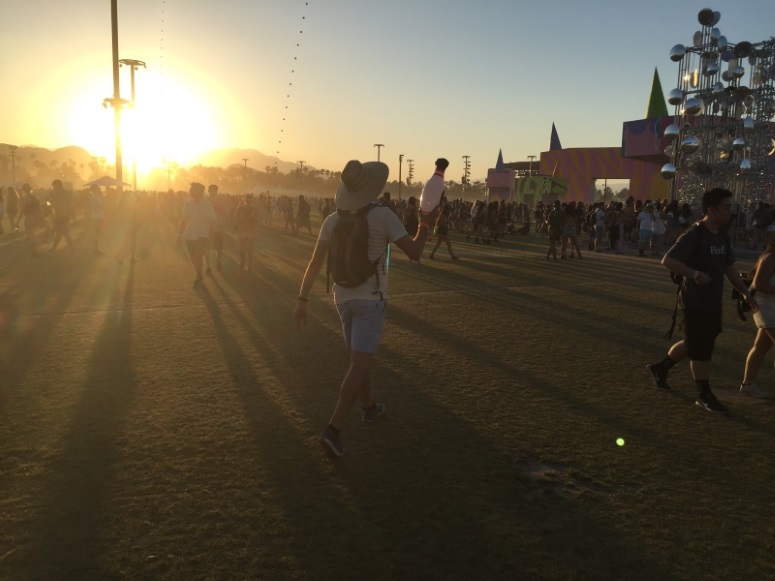
An enthusiastic attendee walks the 2017 Coachella festival grounds at dusk.
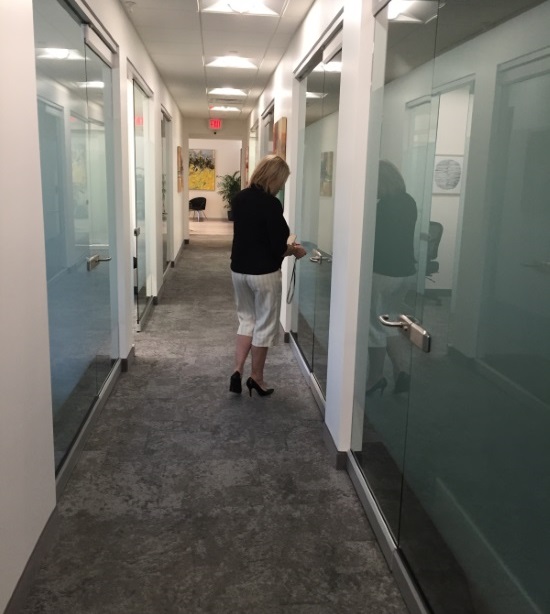
Fusion Workplaces’ Brooke Stackpole touring through the private offices
On my way to Indio’s annual Coachella music extravaganza, I rubbernecked Palm Dessert’s Fusion Workplaces, a mere ten miles from the arid, dusty concert grounds and mountains backdrop—its chic and pristine, individually temperature-controlled offices a veritable oasis from the rugged landscapes outside.
According to general manager Brooke Stackpole, Fusion caters largely to the white-collar workers of Indian Wells, one of the richest per capita towns in the United States. That said, the general area is rife with economic inequality.
“There’s the rich, and there’re those who serve them,” she said.
This particular Fusion Workplaces is owned by a local private businessman who had become interested in the concept of shared workspaces, she said.
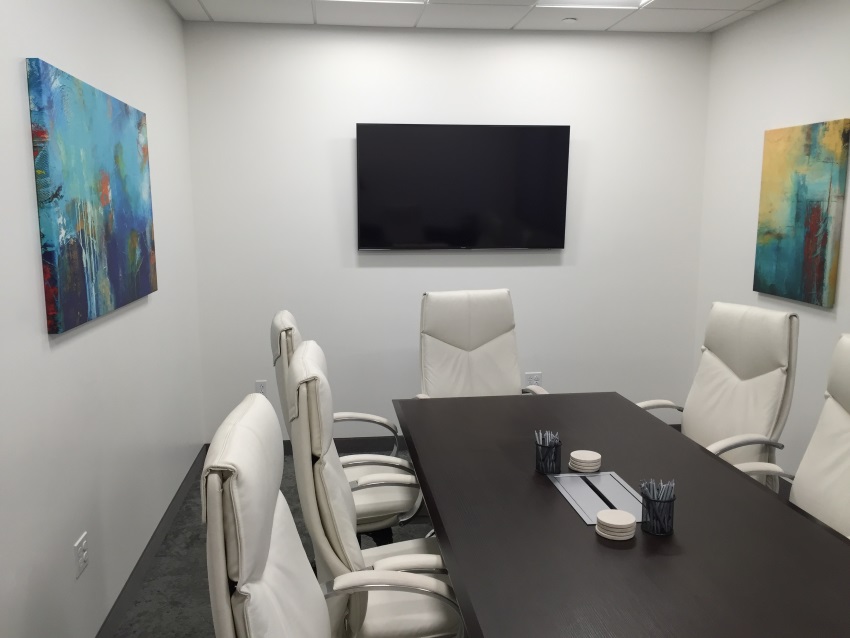
An individually temperature controlled Fusion conference room used for Coworking.
Fusion generally specializes in more of the private office side of the business, but Stackpole was attempting to make a Coworking adjustment to the model after noticing how Coworking keywords were trending on Google. She began pumping out those adwords to reach more workers from outside the area.
“Like people who’re from urban areas know all about it, like people from Los Angeles or Chicago, but for people who’re here full time, it’s just kind of a newer concept.”
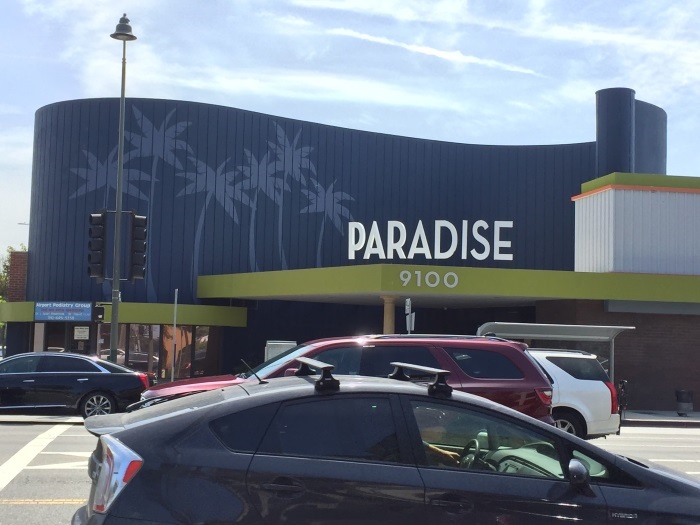 Coworking LAX is located in the old Paradise building, a former movie theater, near the Los Angeles International Airport
Coworking LAX is located in the old Paradise building, a former movie theater, near the Los Angeles International AirportFinally, now that I’d reached my West Coast antipode, it was time to wrap things up. This conclusion came at LAX Coworking, which finds its home in the old Paradise Building–a converted 50s’ hybrid movie theater, cocktail lounge and bowling alley, adjacent to the iconic retro-futuristic Los Angeles International Airport.
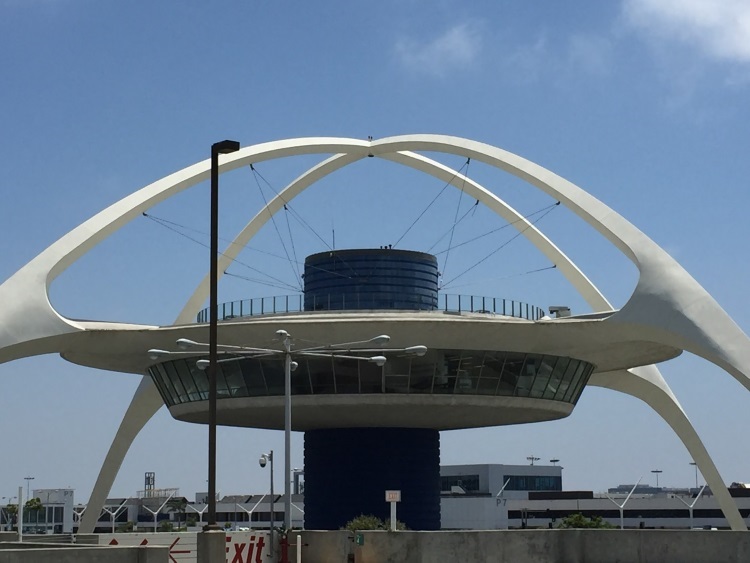
The now vacant but iconic, space age Encounter restaurant at Los Angeles International Airport.
LAX Coworking is glommed to the LAX Coastal Chamber of Commerce, not the most common alignment among the Coworking orbit, but whoever said there was much that was common about this place anyway–at least by LA standards.
“Unpretentious Coworking.”
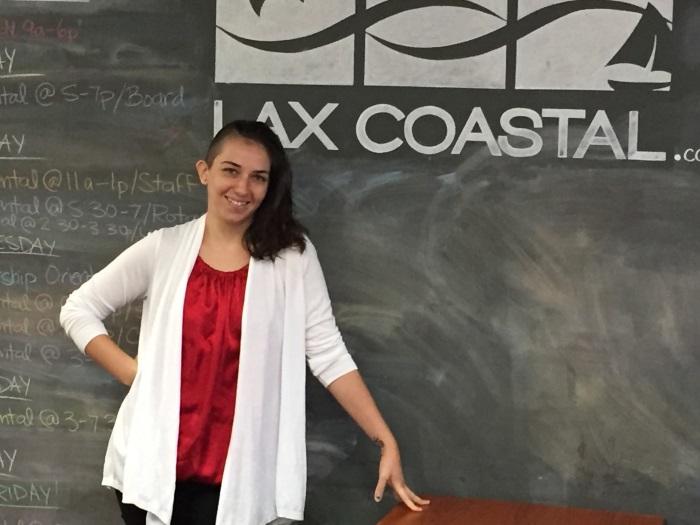
Kirby Israelson is the Coworking community manager at LAX Coworking.
That’s how LAX Coworking brands itself, according to resident art director and Krav Maga instructor Kirby Israelson.
In LA, however, this constitutes as a niche–so in that way they’ve set themselves apart from the manifold options available here. Los Angeles is bristling with them. So for us hailing from Palm Coast, where there’s nothing to be but unpretentious, the sentiment is appreciated.
So in certain respects, for me at least, the more things change, the more they really do stay the same.
Though the inside of this particular work lodge is meant as a shelter of sorts from the surrounding hubbub outside, you still can’t escape a sensory LA experience. Leaving the Paradise Building, a relic of old LA, one is bombarded with the smells of the quintessential California fast food chain, In-and-Out Burger, as jetliners roar above.
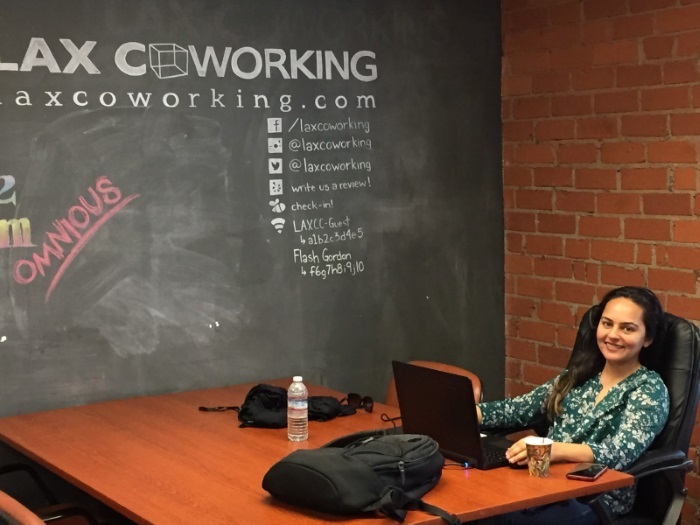
A happy coworker finds a secluded corner of LAX Coworking, a massive chalkboard behind her.
But it was the dynamics happening within the swooshing edifice which made this spot ripe for a final disembarkment.
Israelson said that while there’re a lot of surrounding mega companies in the area, especially within the Playa Vista territory, home to residents (and chamber members) like Facebook, Google and Konami, they, too, have a specialized focus.
Individuals “who are looking to reevaluate their own careers or start their own businesses, so we’ve got a lot of people who’ve spent a lot of time in the corporate world and then have decided to try something on their own,” she said.
“Every Coworking space has its own vibe and ambiance and attracts a different crowd,” Israelson said.
This that I learned first-hand was definitely true.
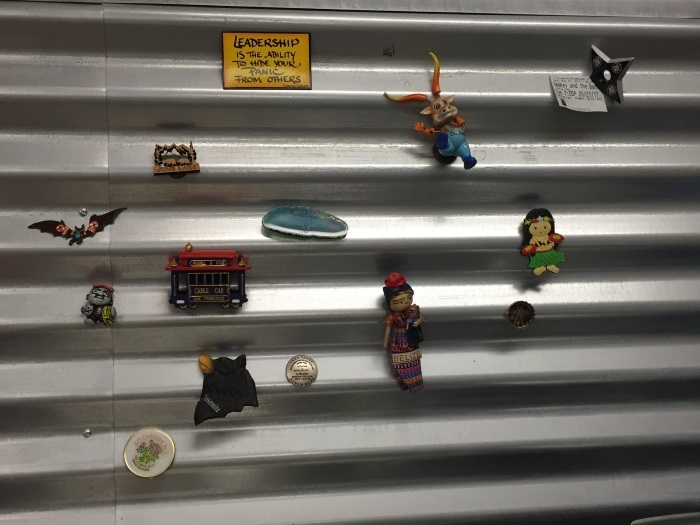
Every time an LAX Coworking member travels somewhere, preferably by air, they’re supposed to return with a key chain souvenir.
Coworking, like almost any other object or service of value to be found within the borders of my trip, is its own free market industry: In exchange for the accessorized space–and services–you pay.
Yet the business of Coworking isn’t a thing so easily quantified. From a bird’s eye view, it almost seems like an entity that exists outside the Capitalistic sphere, something more borne of a Gift Economy. That is, an economy in which commodities are exchanged without any promise of direct or immediate reciprocation–at least reciprocation in terms of goods, excluding of course the modest sum that produces the desired return.
If you’re curious, a real life example of the Gift Economy is practiced just outside that other American border, the one I didn’t come into close contact with on this trip: The gift-giving Potlatch feast of the indigenous people of Canada’s Northwest Coast, their primary means of commerce. Perhaps that could account for my next Coworking sojourn in the other direction, at which point I’ll be able to call myself a Coworking anthropologist.
There’s just so much that seems connected between the Gift Economy concept and that of Coworking, and that might have to do with this: Even in a Gift Economy where no cash is exchanged upfront–or maybe especially because of this–that doesn’t mean nothing is expected back in return, even if there’s no due date attached.
Whatever that return may be is up for conjecture, and it’s certainly not up to this lowly traveler to say. Still, I still feel comfortable saying it’s not about paying the venue back, nearly as much as it is paying the time you spent there forward to the surrounding locality. And probably beyond that, too.
Have you ever been to any of these Coworking locations? Ever Cowork anywhere while traveling? Or maybe, you have a favorite Coworking Space along this route that I’ve not had the chance to visit/highlight? Feel free to chime in with a comment below!

- COWORKING From Palm Coast to LAX - January 16, 2018
- Toilet Paper: Over or Under? - January 16, 2017
- 2016: Year In Review - December 28, 2016
